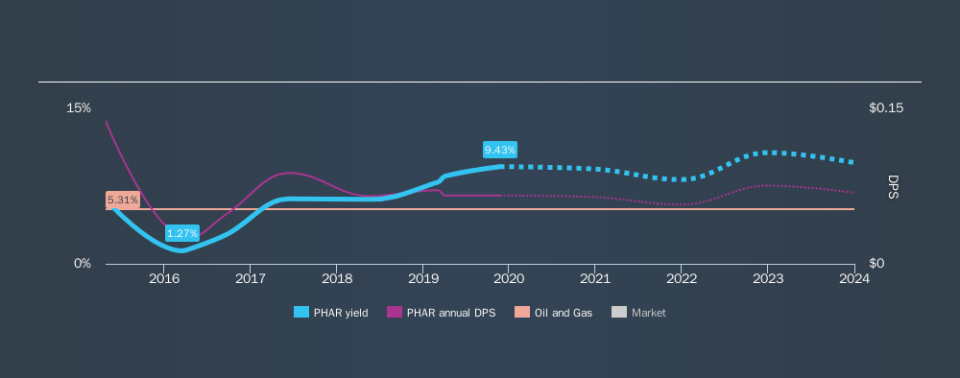Is Pharos Energy plc (LON:PHAR) A Good Dividend Stock?

Dividend paying stocks like Pharos Energy plc (LON:PHAR) tend to be popular with investors, and for good reason - some research suggests a significant amount of all stock market returns come from reinvested dividends. If you are hoping to live on the income from dividends, it's important to be a lot more stringent with your investments than the average punter.
In this case, Pharos Energy likely looks attractive to dividend investors, given its 9.4% dividend yield and five-year payment history. We'd agree the yield does look enticing. There are a few simple ways to reduce the risks of buying Pharos Energy for its dividend, and we'll go through these below.
Explore this interactive chart for our latest analysis on Pharos Energy!
Payout ratios
Dividends are typically paid from company earnings. If a company pays more in dividends than it earned, then the dividend might become unsustainable - hardly an ideal situation. So we need to form a view on if a company's dividend is sustainable, relative to its net profit after tax. Although Pharos Energy pays a dividend, it was loss-making during the past year. When a company is loss-making, we next need to check to see if its cash flows can support the dividend.
Pharos Energy paid out 105% of its free cash last year. Cash flows can be lumpy, but this dividend was not well covered by cash flow.
Is Pharos Energy's Balance Sheet Risky?
Given Pharos Energy is paying a dividend but reported a loss over the past year, we need to check its balance sheet for signs of financial distress. A quick check of its financial situation can be done with two ratios: net debt divided by EBITDA (earnings before interest, tax, depreciation and amortisation), and net interest cover. Net debt to EBITDA measures total debt load relative to company earnings (lower = less debt), while net interest cover measures the ability to pay interest on the debt (higher = greater ability to pay interest costs). Pharos Energy has net debt of 0.31 times its EBITDA, which is generally an okay level of debt for most companies.
We calculated its interest cover by measuring its earnings before interest and tax (EBIT), and dividing this by the company's net interest expense. With EBIT of 31.48 times its interest expense, Pharos Energy's interest cover is quite strong - more than enough to cover the interest expense.
Remember, you can always get a snapshot of Pharos Energy's latest financial position, by checking our visualisation of its financial health.
Dividend Volatility
From the perspective of an income investor who wants to earn dividends for many years, there is not much point buying a stock if its dividend is regularly cut or is not reliable. Pharos Energy has been paying a dividend for the past five years. During the past five-year period, the first annual payment was US$0.14 in 2014, compared to US$0.066 last year. Dividend payments have fallen sharply, down 52% over that time.
When a company's per-share dividend falls we question if this reflects poorly on either external business conditions, or the company's capital allocation decisions. Either way, we find it hard to get excited about a company with a declining dividend.
Dividend Growth Potential
With a relatively unstable dividend, and a poor history of shrinking dividends, it's even more important to see if EPS are growing. It's not great to see that Pharos Energy's have fallen at approximately 9.5% over the past five years. A modest decline in earnings per share is not great to see, but it doesn't automatically make a dividend unsustainable. Still, we'd vastly prefer to see EPS growth when researching dividend stocks.
Conclusion
When we look at a dividend stock, we need to form a judgement on whether the dividend will grow, if the company is able to maintain it in a wide range of economic circumstances, and if the dividend payout is sustainable. Pharos Energy's dividend is not well covered by free cash flow, plus it paid a dividend while being unprofitable. Second, earnings per share have been in decline, and its dividend has been cut at least once in the past. Using these criteria, Pharos Energy looks quite suboptimal from a dividend investment perspective.
Without at least some growth in earnings per share over time, the dividend will eventually come under pressure either from costs or inflation. Businesses can change though, and we think it would make sense to see what analysts are forecasting for the company.
If you are a dividend investor, you might also want to look at our curated list of dividend stocks yielding above 3%.
If you spot an error that warrants correction, please contact the editor at editorial-team@simplywallst.com. This article by Simply Wall St is general in nature. It does not constitute a recommendation to buy or sell any stock, and does not take account of your objectives, or your financial situation. Simply Wall St has no position in the stocks mentioned.
We aim to bring you long-term focused research analysis driven by fundamental data. Note that our analysis may not factor in the latest price-sensitive company announcements or qualitative material. Thank you for reading.

